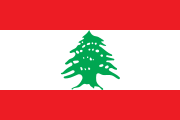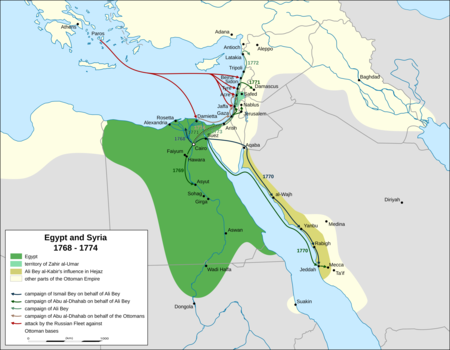Portal:Lebanon
The Lebanon PortalA view of Byblos, Lebanon
 Lebanon (/ˈlɛbənɒn, -nən/ ⓘ LEB-ə-non, -nən; Arabic: لُبْنَان, romanized: Lubnān, local pronunciation: [lɪbˈneːn]), officially the Republic of Lebanon, is a country in the Levant region of West Asia. It is bordered by Syria to the north and east, by Israel to the south, and by the Mediterranean Sea to the west; Cyprus lies a short distance away from the country's coastline. Lebanon's location at the crossroads of the Mediterranean Basin and the Arabian hinterlands has contributed to the country's rich history and shaped a unique cultural identity shaped by religious diversity. Lebanon has a population of more than five million people and covers an area of 10,452 square kilometres (4,036 sq mi). Lebanon's capital and largest city is Beirut, followed by Tripoli and Jounieh. While Arabic is the official language, French is also recognized in a formal capacity; Lebanese Arabic is the country's vernacular, though French and English play a relatively significant role in everyday life, with Modern Standard Arabic being limited to news and government matters. The earliest evidence of human civilization in Lebanon dates back to 5000 BCE. From 3200 to 539 BC, what was to become Lebanon was part of Phoenicia, a maritime empire that stretched the Mediterranean Basin. In 64 BC, the Roman Empire conquered the region, and Lebanon soon became a major center for Christianity under the aegis of the Byzantine Empire. In the 7th century, the Muslim conquest of the Levant brought the region under the control of the Rashidun Caliphate. The 11th century saw the beginning of the Crusades and the establishment of Crusader states, which later fell to the Ayyubids and the Mamluks, who in turn ceded the territory to the Ottoman Turks in the aftermath of the Ottoman–Mamluk War of 1516–1517. Under Ottoman ruler Abdulmejid I, the first Lebanese proto-state was established in the form of the Mount Lebanon Mutasarrifate, created in the 19th century as a home for Maronite Christians under the Ottoman "Tanzimat" period. Lebanon is a developing country, ranked 112th on the Human Development Index. It has been classified as an upper-middle-income state. The Lebanese liquidity crisis, coupled with nationwide corruption and recent disasters such as the 2020 Beirut explosion, have precipitated the collapse of Lebanon's currency and fomented political instability, widespread resource shortages, and high unemployment and poverty. The World Bank has defined Lebanon's economic crisis as one of the world's worst since the 19th century. Despite the country's small size, Lebanese culture is renowned both in the Arab world and globally, powered primarily by the Lebanese diaspora. Lebanon is a founding member of the United Nations and of the Arab League, and is a member of the Non-Aligned Movement, the Organization of Islamic Cooperation, the Organisation internationale de la Francophonie, and the Group of 77, among others. (Full article...) This is a Featured article, one of the best articles Wikipedia has to offer.
 Beirut was twice occupied during the Russo-Turkish War of 1768–1774 by squadrons of the Imperial Russian Navy's Mediterranean Fleet, first in June 1772 and second from October 1773 to early 1774, as part of its Levant campaign. Russia's main objective in this campaign was to assist local forces led by Egypt's autonomous ruler, Ali Bey al-Kabir, who was in open rebellion against the Ottoman Empire. Russia, led by Catherine the Great, was pressing the Ottomans in Europe. Ali took advantage of the Empire's preoccupation with Russia to declare Egypt's independence; in 1771 he sent an army led by Muhammad Bey Abu al-Dhahab to occupy Ottoman territory in the Levant. Abu al-Dhahab unexpectedly returned to challenge Ali for control of Egypt. Ali requested Russian military assistance against both his rival and the Ottomans. When this aid, in the form of a small Russian squadron, arrived in the region, Ali had already fled Egypt and taken refuge in Acre, the power base of his ally, Zahir al-Umar. After helping repel an Ottoman offensive on Sidon, the Russian squadron sailed for Beirut. They bombarded the town in June 1772 and occupied it from June 23 to 28. Ali requested further assistance from Russia to recover Egypt from Abu al-Dhahab. The Russians had recently entered a period of truce with the Ottomans, constraining their involvement in the region. They did, however, promise Ali a large squadron. Impatient, Ali set out for Egypt with a small force that was defeated near Cairo; he was imprisoned and died a few days later. When the Russian squadron arrived in June 1773 and learned of Ali's fate, its commander allied with Zahir and the Druze chieftain Yusuf Shihab. The latter had agreed to pay the Russians a tribute in exchange for their liberation of Beirut from Jazzar Pasha, Shihab's insubordinate vassal whom he had recently appointed as governor of the town. The bombardment of the town began on August 2, and Jazzar surrendered after two months, on October 10. A few hundred Albanian mercenaries were left as occupiers. (Full article...)Did you know (auto-generated) -
TopicsRelated portalsReligions in Lebanon Arab states This is a Good article, an article that meets a core set of editorial standards.
The 1585 Ottoman expedition against the Druze, also called the 1585 Ottoman invasion of the Shuf, was an Ottoman military campaign led by Ibrahim Pasha against the Druze and other chieftains of Mount Lebanon and its environs, then a part of the Sidon-Beirut Sanjak of the province of Damascus Eyalet. It had been traditionally considered the direct consequence of a raid by bandits in Akkar against the tribute caravan of Ibrahim Pasha, then Egypt's outgoing governor, who was on his way to Constantinople. Modern research indicates that the tribute caravan arrived intact and that the expedition was instead the culmination of Ottoman attempts to subjugate the Druze and other tribal groups in Mount Lebanon dating from 1518. In 1523–1524 dozens of Druze villages were burned in the Chouf area and hundreds of Druze were killed or captured by the governor Khurram Pasha, after which a period of peace ensued. Tensions resumed in the 1560s as Druze and non-Druze local dynasties, particularly the Ma'ns, Assafs and Shihabs, acquired large quantities of prohibited firearms, which were often superior to those possessed by government troops. Military action by the Ottoman governors of Damascus in the 1570s failed to disarm the chiefs and the general population or collect tax arrears, which had been building up from the 1560s. Ibrahim Pasha was appointed to "rectify the situation" in the Levant in 1583 and launched the expedition against the Druze of Mount Lebanon in the summer of 1585 as a Porte-ordered diversion for his Constantinople-bound caravan. He mobilised about 20,000 soldiers, including the Janissaries of Egypt and Damascus, as well as local chieftains, namely the Bedouin Mansur ibn Furaykh and Druze rivals of the Ma'ns. Hundreds of Druze rebels were slain, thousands of muskets were confiscated and large sums of money were collected as tax arrears by Ibrahim Pasha. The Ma'nid chief Qurqumaz, one of the principal targets of the expedition, died in hiding after refusing to surrender. (Full article...)General imagesThe following are images from various Lebanon-related articles on Wikipedia.
CategoriesAssociated WikimediaThe following Wikimedia Foundation sister projects provide more on this subject:
SourcesDiscover Wikipedia using portals |






















































